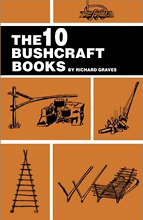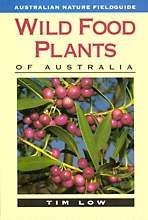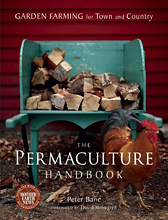Instant Bookshelf to Survive The Apocalypse
See Also: Survival Books, Survival DVDs, Books by Tom Brown, Jr., Permaculture, Self Sufficiency And Sustainable Living Books, Australian Field Guides and Nature Books, Dystopian Fiction / Novels, and Books About Near-Death Experiences.
NOTE: This page is in the process (as of mid-2024) of being migrated from survival.ark.au/bookshelf.php to ark.au/bookshelf.html. It will be further updated soon...
See Also: Survival Books, Survival DVDs, Books by Tom Brown, Jr., Permaculture, Self Sufficiency And Sustainable Living Books, Australian Field Guides and Nature Books, Dystopian Fiction / Novels, and Books About Near-Death Experiences.
This page shows a collection books to survive a collapse of modern society. Of course there are a lot more books you could get. I've selected the best ones I've found so far in a few essential categories.
Currently there are 24 books, which would fit on a single shelf.
If I had to choose only one shelf of books with which to survive a collapse of modern society, these would be the books.
A couple are freely downloadable in electronic form. Electronic books (e-books) are good for storing a lot in a small physical space — however after a collapse of society, there may not be a reliable power source for your electronic reading device(s). After a few years (or less if there's no power to charge it), the battery in your device will die. Assuming there's no more replacement batteries available, the device will be of little use. Replacement batteries generally won't store well (worse than a battery in use for Li-ion types). If there is an EMP event, your device will die the instant the EMP happens (unless it's deliberately shielded/hardened against EMP, along with it's charger and a source of electricity to power the charger).
 IMPORTANT: Physical, paper books will last much, much longer than this. And will still be readable irrespective of whether or not you have electrical power. IMPORTANT: Physical, paper books will last much, much longer than this. And will still be readable irrespective of whether or not you have electrical power.
General Preparedness Books
|
 NEW: The Art of Resilience: Strategies for an Unbreakable Mind and Body, by Ross Edgley.
NEW: The Art of Resilience: Strategies for an Unbreakable Mind and Body, by Ross Edgley. This is a truly amazing book, which tells the story of the first person to swim all the way around Great Britain. It also gives a huge amount of background information on how to train your body to be strong and fit (that's an understatement). He gives many examples of people and of entire cultures (such as the traditional culture of Kenya) who learned to develop "The Art of Resilience".
It's more of a biographical/story styled book than a how-to manual as such, but it contains a massive amount of how-to information. I learned a heap (especially in terms of motivation, and some survival-related facts also) just from flicking through it for ten minutes in the bookshop. I'll write more about it when I've read more of it. First published May 2020 in hardcover, and June 2020 in softcover.
From the publishers:
Bestselling author and award-winning adventurer Ross Edgley has been studying the art of resilience for years, applying all he has learned to become the first person in history to swim around Great Britain, breaking multiple world records. Now Ross focuses on mental strength, stoicism and the training needed to create an unbreakable body.
Ross Edgley famously ran a marathon pulling a 1.4-tonne car and climbed a rope the height of Everest (8,848m), after living with Yamabushi warrior monks in Japan and partaking in Shamanic pain rituals with fire ants in the Amazon jungle. On his epic 1,780-mile journey around Great Britain, which lasted 157 days, Ross swam through giant jellyfish, arctic storms, ‘haunted' whirlpools and polluted shipping lanes, going so hard, and so fast, his tongue fell apart.
Ross's previous book, The World's Fittest Book, was a Sunday Times No.1 bestseller and explored the science of physical fitness. Now, in The Art of Resilience, Ross uses his swim experience and other amazing endurance feats, where he managed to overcome seemingly insurmountable pain, hardship and adversity, to study the performance of extreme athletes, military and fitness specialists and psychologists to uncover the secrets of mental fitness and explore the concept of resilience, persistence, valour and a disciplined mindset in overcoming adversity.
This ground-breaking book represents a paradigm shift in what we thought the human body and mind were capable of and will give you a blueprint to become a tougher, more resilient and ultimately better human — whatever the challenge you face.
Purchase from Amazon.com.au (Australian Site)
|
|
 The Art of Resilience had almost a whole shelf to itself when I bought it in Sydney — plus another small shelf around the corner from this one, plus another spot elsewhere in the shop. |
|
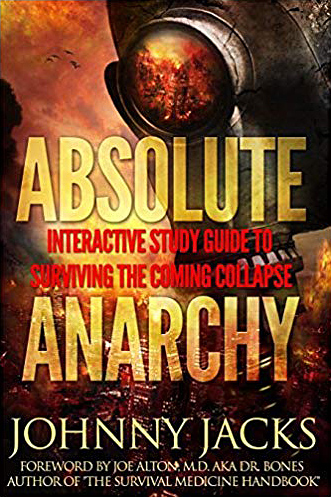 Absolute Anarchy, by Johnny Jacks.
Absolute Anarchy, by Johnny Jacks. This is an excellent book. In fact it's currently the one I'd recommend most of all if you only got one book, in terms of overall coverage of how to survive a collapse of modern civilisation.
From the publisher's information:
Johnny Jacks was born to semiliterate sharecropper parents on January 11, 1944, in Montgomery, Alabama, six months before D-day.
In 1949, several years after WWII and without the means to establish a farm, his family — parents and little sister — moved to Comanche County, Texas where his father's brother helped them to acquire temporary shelter in an old one-room slave house and a 40-acre farm to sharecrop. There he quickly became aware of the demands of living self-reliantly off grid, off city water, without indoor plumbing, and without assistance from a welfare state. In those days, if they didn't grow vegetables, milk the cow, raise and slaughter pigs, raise chickens, harvest wildlife, and preserve their own food, they didn't eat, especially in winter. They eventually moved to a small house that had electricity, but still obtained water from a hand-dug well and made use of a privy with Sears and Roebuck catalogues and corncobs in lieu of toilet paper.
In 1954, following the tragic loss of their farm equipment to a fire, including the tractor, his disheartened father returned them to Alabama where he obtained work in a veneer mill near Selma. They later relocated to Mobile where his father became a common laborer, moving from job to job, anything that provided enough pay to meet their basic survival needs. At the age of twelve, Johnny mowed lawns to help pay the bills and provide for his own needs.
On his seventeenth birthday, he enlisted in the U.S. Air Force, later transferring to the U.S. Army where he became a Special Forces soldier, a Green Beret. He completed training at the U.S. Army Special Warfare Center at Fort Bragg, North Carolina in the spring of 1966 and began a career serving on Special Forces A teams in Europe, Asia, and Central America, including a combat assignment to Special Forces A team 102, Tien Phuoc, Vietnam, 1967-1968. He became proficient in guerrilla warfare strategies and tactics, communications, intelligence gathering, and guerrilla group organization and operations.
After retiring from the Army in 1982, he worked for several government agencies over the next thirty years in significant positions involving national security and emergency preparedness program implementation and policy-making. These roles provided him with knowledge of the national security policy relating to continuity of government and continuity of operations with insight into what will take place with the senior leadership when the Schumer hits the fan and the nation falls into a state of absolute anarchy.
This combination of experience and education in off-grid, self-reliant living, guerrilla warfare, and national security policy imbued him with unique insight into today's individual and group prepper survival needs and requirements and gave him the skills and knowledge needed to defeat organized gangs and other bad guys and assist refugees under a state of absolute anarchy.
Purchase from Amazon.com (USA Site)
Purchase from Amazon.com.au (Australian Site)
| The Foxfire Books
 NEW I've recently discovered the Foxfire series of books. These are excellent. They contain a massive amount of information on how to live like people did in the days just before modern technology, as told to high school students by a large number of people (mostly older people) whom they interviewed. Some of the content is stories, and a lot of it is very detailed technical descriptions, with illustrations, of how to do things. NEW I've recently discovered the Foxfire series of books. These are excellent. They contain a massive amount of information on how to live like people did in the days just before modern technology, as told to high school students by a large number of people (mostly older people) whom they interviewed. Some of the content is stories, and a lot of it is very detailed technical descriptions, with illustrations, of how to do things.
There are a lot of them, at least 15, and you probably don't need to get them all. The first 12 are numbered (as in Foxfire 1, Foxfire 2, etc.). The first one was published in 1972, and then one every 1-2 years with some gaps.
I'll update this page soon with more detailed information and proper reviews of the first few Foxfire books. And with proper individual links to buy the books. The links below point to searches for them. Note that not all of the books returned from these searches are the actual Foxfire books that we're talking about here, but after seeing descriptions of a few of them you should be able to tell which are and which are not. For example, "Foxfire: Confessions of a Girl Gang" is not.
Foxfire books here from Amazon Australia
Foxfire books here from Amazon (US)
|
 The LDS Preparedness Manual.
The LDS Preparedness Manual.
This is a free downloadable PDF book. Highly recommended. Yes "LDS" refers to the Mormon Church (i.e. the Church of Jesus Christ of Latter-day Saints), but there is a massive amount of content in here that will be useful for everyone. There is also a hard copy version available from Amazon (US), which at the time I'm writing this has 42 reviews, 41 of them 5/5 stars, and one 4/5.
Free download link here. (Note that it asks for your email address, but any email address will do, e.g. john@msn.com.) If you click on the link you can view the table of contents on the HTML page before you download it.
Purchase from Amazon (US) |
|
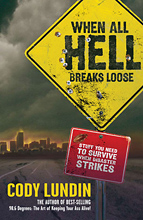 When All Hell Breaks Loose: Stuff You Need To Survive When Disaster Strikes, Cody Lundin. I love this book. It's a really fun book — well, as close to fun as you can get when writing about a topic like this. There are silly characters like a talking cow, and things like that, which can really help to ease some of the "This is it: we're all going to die" feeling of doom that this subject can sometimes bring up.
When All Hell Breaks Loose: Stuff You Need To Survive When Disaster Strikes, Cody Lundin. I love this book. It's a really fun book — well, as close to fun as you can get when writing about a topic like this. There are silly characters like a talking cow, and things like that, which can really help to ease some of the "This is it: we're all going to die" feeling of doom that this subject can sometimes bring up.
There are a few bad reviews of it on Amazon by people who don't like this kind of approach (if you are one of these people, you would probably prefer a book like Rawles' one, which is in some ways more advanced than this one).
This would be a great book (perhaps the best one I've seen) to buy for someone "normal" (i.e. who isn't heavily into this "survivalist" stuff already).
Purchase from Amazon Australia
Purchase from Australia (The Nile) (free shipping)
Click here to Purchase from Amazon (US) |
|
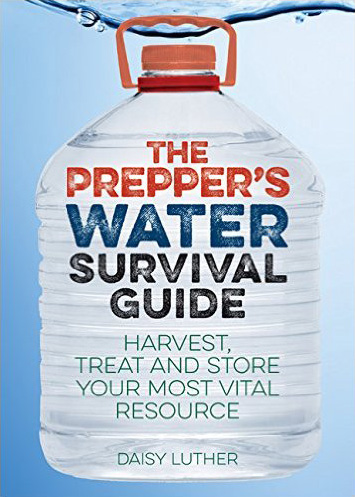 The Prepper's Water Survival Guide: Harvest, Treat, and Store Your Most Vital Resource, by Daisy Luther.
The Prepper's Water Survival Guide: Harvest, Treat, and Store Your Most Vital Resource, by Daisy Luther. You can survive up to three weeks without food, but only three days without water! When catastrophe strikes, having enough water can spell the difference between life and death. The Prepper's Water Survival Guide offers a step-by-step plan with straightforward information you can easily follow. Thanks to this book's laser-focus on water, you'll quickly learn how to store fresh water, collect rainwater, purify water from lakes & rivers, and dig a well for groundwater.
In addition to harvesting water, you'll gain the tools to keep large stores untainted for long periods of time, test the water you collect for dangerous toxins, and treat water-related illnesses that are commonly contracted during a disaster.
Purchase from Amazon.com (USA Site)
Purchase from Amazon.com.au (Australian Site)
| Survival and "Pioneer" Living Books
This books I am writing about on this page are more for longer-term wilderness living skills. For short-term wilderness survival skills (such as you would need if you got lost in the wilderness), see Survival Essentials: How To Survive In The Wilderness. The book I recommend on that page is "Wilderness Survival" by Gregory J. Davenport.
|
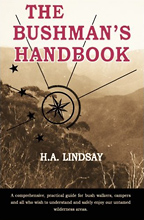 NEW: The Bushman's Handbook, by H. A. Lindsay. This is a really good re-published vintage book about surviving and living in the Australian bush. Vintage books are often better than modern ones, because more people knew and lived these skills back then.
NEW: The Bushman's Handbook, by H. A. Lindsay. This is a really good re-published vintage book about surviving and living in the Australian bush. Vintage books are often better than modern ones, because more people knew and lived these skills back then.
Here's what the Literary Editor of Adelaide's Advertiser newspaper had to say about "The Bushman's Handbook" in late 1948: "If an ordinary city dweller were to be dumped down in the arid central regions of Australia it is fairly certain that if the season was cold he would perhaps survive a few days, but it's also certain that in the heat of summer he would be dead within 48 hours. But the aborigine would be quite at home in such circumstances, which would not be dire straits to him at all. He would know how to find water where apparently none existed, and would unearth sufficient food to enable him to travel safely to better country. The author of "The Bushman's Handbook", who is an expert bushman and descendant of bushmen, and who instructed thousands of Australian and American troops in bushcraft during WWII, here tells exactly how to survive in inhospitable terrain. As to your thirst, he describes how moisture may be obtained from the stems of plants and the limbs of trees - and he shows by illustrations just how the parched outback traveler should proceed. Food can be obtained from all sorts of unlikely sources - for instance, the bilious-looking but tasty and nutritious "witjuti" grubs can be gouged out from the bark of trees. For larger foods the reader is carefully instructed how to make simple but effective snares - to the undoing of rabbits, hares, squirrels and similar game. If you are near streams or pools you have no need to hunger if you follow the Author's instructions and diagrams which will enable you to catch the various kinds of fish without rod, reel or hook. There are also interesting and instructive talks about fire lighting (without matches); the art of camping out; direction finding if you happen to be lost; or how to cord and thatch a shelter for yourself; and on the various special plants and roots which it is safe to eat if driven to extremities. Lastly, the Author gives valuable advice on how to maintain health in the bush, and stresses the value of bushcraft, and the hardiness and self-reliance which it brings, in both peace and war. In all, an admirable and comprehensive bushman's text-book."
Four of the 18 chapters (43 out of 176 pages) are entirely dedicated to finding water in the bush.
Click here to purchase from Amazon Australia
Click here to purchase from Australia (Fishpond) (Probably Unavailable)
Click here to Purchase from Amazon (US) |
|
 Ultimate Guide to Wilderness Living: Surviving with Nothing But Your Bare Hands and What You Find in the Woods, John & Geri McPherson. This is a new version of this important wilderness survival book, under a different title. If you have this book already, don't get the new one since its almost the same content. If you don't have "Naked Into the Wilderness" yet, then this new one is the one to get.
Ultimate Guide to Wilderness Living: Surviving with Nothing But Your Bare Hands and What You Find in the Woods, John & Geri McPherson. This is a new version of this important wilderness survival book, under a different title. If you have this book already, don't get the new one since its almost the same content. If you don't have "Naked Into the Wilderness" yet, then this new one is the one to get.
From the publishers, "In-depth instructions and step-by-step photos of real survival skills — exactly what one needs to stay alive in the woods. The book first covers immediate needs like starting a fire, erecting temporary shelter, and finding food. Then it goes beyond other survival books by explaining advanced techniques for long-term living in the wild — using only those things found in nature. The authors show how to make tools by chipping stones, fashion a bow-and-arrow out of tree branches, weave baskets, fire primitive pots, build a semi-permanent shelter, and even tan hides. Finally, the authors explain how to bring all these skills together to live in the wilderness for days, weeks, months, or even years."
Purchase from Australia (Booktopia)
Purchase from Australia (Angus & Robertson) 
Purchase from Australia (The Nile) (Probably unavailable)
Click here to purchase from Australia (Fishpond)
Click here to purchase from Amazon.com |
|
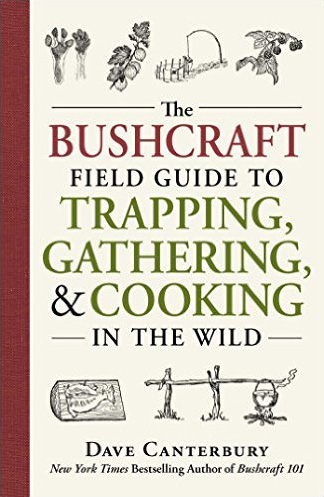 The Bushcraft Field Guide to Trapping, Gathering, and Cooking in the Wild, by Dave Canterbury.
The Bushcraft Field Guide to Trapping, Gathering, and Cooking in the Wild, by Dave Canterbury. Renowned outdoors expert and New York Times bestselling author Dave Canterbury provides you with all you need to know about packing, trapping, and preparing food for your treks and wilderness travels. Whether you're headed out for a day hike or a weeklong expedition, you'll find everything you need to survive--and eat well--out in the wild.
Canterbury makes certain you're set by not only teaching you how to hunt and gather, but also giving you recipes to make while on the trail. Complete with illustrations to accompany his instructions and a full-color photo guide of plants to forage and those to avoid, this is the go-to reference to keep in your pack.
The Bushcraft Field Guide to Trapping, Gathering, and Cooking in the Wild helps you achieve the full outdoor experience. With it, you'll be prepared to set off on your trip and enjoy living off the land.
Purchase from Amazon.com (USA Site)
Purchase from Amazon.com.au (Australian Site)
|
|
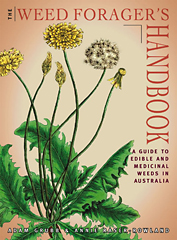 The Weed Forager’s Handbook, Adam Grubb and Annie Raser-Rowland. This is the best Australian book on edible weeds that's currently in print that I know of. Most of the book is about the author's top 20 edible weeds, with each weed getting a few pages that include detailed photos and drawings for identification. First published in 2012. The Weed Forager’s Handbook, Adam Grubb and Annie Raser-Rowland. This is the best Australian book on edible weeds that's currently in print that I know of. Most of the book is about the author's top 20 edible weeds, with each weed getting a few pages that include detailed photos and drawings for identification. First published in 2012.
"Step into the world of our least admired botanical companions, peel back the layers of prejudice, and discover the finer side of the plants we call weeds. This book reveals how to distinguish a tasty sandwich-filler from its dangerous look-alike, which weeds are among the most nutritious vegetables ever tested, and how you cook with delicious nettles without fear of being stung ...It will forever change your concept of where to go looking for lunch."
Purchase from Australia (Booktopia)
Purchase from Australia (Angus & Robertson) 
Purchase from Australia (The Nile)
Click here to purchase from Australia (Fishpond)
Purchase from Amazon |
|
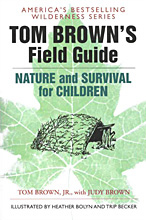 Tom Brown's Field Guide to Nature and Survival for Children, Tom Brown Jr. with Judy Brown. This is Tom Brown's field guide intended for older children, or (mainly) for parents to read and teach to their children. It contains the basics of some of Tom's other field guides (most notably "Wilderness Survival" and "Nature Observation and Tracking") so it can also be used by anyone who wants to learn the basics without having to purchase several guides.
Tom Brown's Field Guide to Nature and Survival for Children, Tom Brown Jr. with Judy Brown. This is Tom Brown's field guide intended for older children, or (mainly) for parents to read and teach to their children. It contains the basics of some of Tom's other field guides (most notably "Wilderness Survival" and "Nature Observation and Tracking") so it can also be used by anyone who wants to learn the basics without having to purchase several guides.
Since Tom's books tend to be on the side of too much information rather than not enough, just the "basics" in his eyes actually makes up a huge amount of information. With 220 pages of small writing it's not exactly written for five year-olds. Which makes this book an extremely good (I think one of the best) all-round wilderness survival books to learn from, even for adults.
If you want to go into more depth with any of the topics covered, you can always do that but this book gives a really good grounding in all of the basics. I like Tom's philosophy and I find that it makes the book much more interesting than the purely technical books such as Davenport and the US Army Survival Manual. I love the chapter called "Society of Robots" where he writes about getting children out into the wilderness as the antidote to the boredom and dissillusionment that is such a massive part of modern life.
It's also nice that it's one of the few non-Australian survival books that doesn't have a plants chapter with a whole lot of plants that we don't have in the Australian wilderness.
Purchase or read reviews on Amazon.com.au
Purchase from Amazon (US)
Click here to read about more of Tom Brown's books |
|
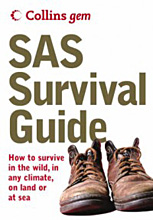 Collins Gem SAS Survival Guide, John 'Lofty' Wiseman. The great advantage of this guide is that it is very much a pocket survival guide. The book is tiny, 11.5 cm by 8 cm and 2.5 cm thick. For such a small book it has a huge amount of information in its 384 pages. That means the writing is very small. It is great to pack into places that you might not take a larger book. It is also quite cheap so there is no excuse not to have one of these if you are interested in survival information. The author John 'Lofty' Wiseman served in the SAS for 26 years so he knows his stuff. The plants section contains northern hemishpere plants (it's published in the United Kingdom).
Collins Gem SAS Survival Guide, John 'Lofty' Wiseman. The great advantage of this guide is that it is very much a pocket survival guide. The book is tiny, 11.5 cm by 8 cm and 2.5 cm thick. For such a small book it has a huge amount of information in its 384 pages. That means the writing is very small. It is great to pack into places that you might not take a larger book. It is also quite cheap so there is no excuse not to have one of these if you are interested in survival information. The author John 'Lofty' Wiseman served in the SAS for 26 years so he knows his stuff. The plants section contains northern hemishpere plants (it's published in the United Kingdom).
Click here to purchase from Australia (Fishpond)
Purchase from Australia (The Nile, probably unavailable)
Purchase from Amazon (US) |
|
 Shelters, Shacks, and Shanties: The Classic Guide to Building Wilderness Shelters, by D. C. Beard. The classic guide from 1914 on building low tech dwellings using only natural locally obtained materials (mainly from trees) and only a hatchet or axe. The book is split into two parts, the first part being shelters you can build with just a hatchet, and the second part those built with a full size axe.
Shelters, Shacks, and Shanties: The Classic Guide to Building Wilderness Shelters, by D. C. Beard. The classic guide from 1914 on building low tech dwellings using only natural locally obtained materials (mainly from trees) and only a hatchet or axe. The book is split into two parts, the first part being shelters you can build with just a hatchet, and the second part those built with a full size axe.
This excellent hands-on guide by one of the founders of the Boy Scouts of America contains a wealth of practical instruction and advice on how to build everything from a bark teepee and a tree-top house to a log cabin and a sod house. No professional architects are needed here; and knowing how to use an axe is more important than possessing carpentry skills. More than 300 of the author's own illustrations and a clear, easy-to-follow text enable campers to create such lodgings as half-cave shelters, beaver mat huts, birch bark shacks, over-water camps, a Navajo hogan, and a pole house.
Additional chapters provide information on how to use an axe, split and notch logs, make a fireplace, and even build appropriate gateways to log houses, game preserves, ranches, and other open areas. An invaluable book for scouts, campers, hikers, and hunters of all ages, this guide and its fascinating collection of outdoor lore will be of keen interest to any modern homesteader.
There are more versions of this book available than just about any other book I've ever seen apart from the Bible and other religions' Holy Books. I have the Dover Publications one which is fine. Some of the more expensive ones presumably have better quality paper.
Click here to purchase from Amazon Australia
Click here to purchase from Australia (Fishpond)
Click here to purchase from Australia (The Nile)
Click here to Purchase from Amazon (US) |
Medical Books
|
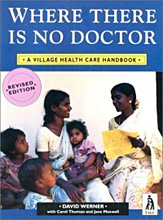 Where There is No Doctor, David Werner. This is the standard medical book for places without modern medical care. It's not a "wilderness medicine" style of book designed to keep you alive until you can be helicopter-lifted to a modern first-world hospital. It's the book to get if you have ever wondered how people would get by in the absence of modern Western high-tech medical care.
Where There is No Doctor, David Werner. This is the standard medical book for places without modern medical care. It's not a "wilderness medicine" style of book designed to keep you alive until you can be helicopter-lifted to a modern first-world hospital. It's the book to get if you have ever wondered how people would get by in the absence of modern Western high-tech medical care.
Having been written for people in third-world countries who might not have much english or a uni degree in medical science, it's also very easy to understand.
From the sales pitch — "With 3 million copies in print in over 50 languages, Where There Is No Doctor is the most widely used health care manual in use in developing countries today. Using simple language and hundreds of drawings, the book provides information about recognising, treating and preventing common illnesses and injuries. But it is far more than simple first aid information. It covers a wide range of subjects that affect the health of the villager - from diarrhoea to tuberculosis, from helpful and harmful home remedies to the cautious use of certain modern medicines. Special importance is placed on cleanliness, a healthy diet, vaccination, childbirth and family planning."
Purchase or read reviews on Amazon.com.au
Click here to purchase from Australia (The Nile) (Probably unavailable) |
|
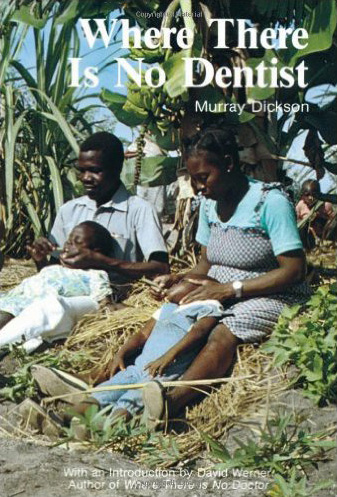 Where There Is No Dentist, by Murray Dickson.
Where There Is No Dentist, by Murray Dickson. This is my favourite of the Christian martyr stories I've read. I really think it's one of those classic books that everyone should read. The product description says "This is the intensely dramatic story of how God took a young, half-starved boy from a poor village in Henan Province and used him mightily to preach the gospel, despite horrific opposition. Brother Yun is one of China's house church leaders, a man who despite his relative youth has suffered prolonged torture and imprisonment for his faith. Instead of focusing on the many miracles or experiences of suffering, however, Yun prefers to emphasise the character and beauty of Jesus. This astonishing book will form a watershed in your spiritual life." It's also available as set of audio CDs, and a comic book style version.
Purchase from Amazon.com (USA Site)
Purchase from Amazon.com.au (Australian Site)
|
|
 The Survival Medicine Handbook: A Guide for When Help is Not on the Way, by Joseph and Amy Alton.
The Survival Medicine Handbook: A Guide for When Help is Not on the Way, by Joseph and Amy Alton. The Survival Medicine Handbook is a guide for those who want to be medically prepared for any disaster where help is NOT on the way. The Survival Medicine Handbook is not your standard first aid book. It assumes that no hospital or doctor is available in the aftermath of a catastrophic event. This book will give you the tools to handle injuries and illness for when YOU might be the end of the line with regards to your family's medical well-being. In circumstances where medical personnel are overwhelmed and access to modern technology is limited or non-existent, The Survival Medicine Handbook is the essential reference book for every library. Written in plain English, you'll find step-by-step instructions on how to identify and treat over 100 different medical issues.
Purchase from Amazon.com (USA Site)
Purchase from Amazon.com.au (Australian Site)
|
Permaculture / Agriculture / Gardening Books
Add specific books about any animals you're interested in farming, at least one good book about each type of animal.
|
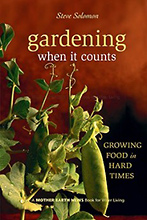 Gardening When It Counts: Growing Food in Hard Times, Steve Solomon. This book covers exactly the things that people will want to know about gardening in a few years time when the food in the shops starts to run short. This is one of the three or four books on this website where I say "don't even think, just get this one".
Gardening When It Counts: Growing Food in Hard Times, Steve Solomon. This book covers exactly the things that people will want to know about gardening in a few years time when the food in the shops starts to run short. This is one of the three or four books on this website where I say "don't even think, just get this one".
When I first started growing vegetables again (again meaning as an adult rather than helping my Dad or my Grandfather), the thing that really concerned me — and depressed me — was how much water was needed to keep them alive in the summer drought. The methods taught in this book are exactly the thing that I have been looking for all this time.
The back cover comments say "Applicable to most areas in the English-speaking world except the tropics or hot deserts [so take that into account if you live in either of those climates], this book shows that any family with access to about 400 square metres of garden land can halve their food costs in most climates using just the odd bucketful of household waste water, a few hand tools, and a few hundred dollars per year spent on supplies and seeds — working just an average of two hours a day during the peak growing season."
More from the back cover: "The decline of cheap oil and the threat of harder times to come is prompting people to grow more food themselves. But currently popular intensive vegetable gardening methods depend on cheap oil, requiring high inputs of water, fertility and organic matter. Prior to the 1970s, home food growing used more land because wider plant spacing reduces the need for irrigation and requires lower levels of soil fertility to be productive — and well-spaced plants can be weeded rapidly and conveniently with hand tools while standing upright. But these efficient systems have been largely forgotten."
"It covers a host of material, including:
- Vegetables ranked by how difficult they are to grow
- Root systems as the key to gardening mastery
- Seeds, spacing and irrigation
- Home made organic fertiliser that really works
- How to choose, use and sharpen hand tools
- Compost making, root-cellaring and irrigation
- Chemical-free handling of insects and diseases"
"Designed for readers with no experience, yet and eye-opener for even the seasoned gardener, Gardening When It Counts returns the backyard food garden to center stage for uncertain times ahead."
Purchase from Amazon Australia
Purchase from Australia (Fishpond)
Purchase from Australia (The Nile)
Purchase from Amazon (US) |
|
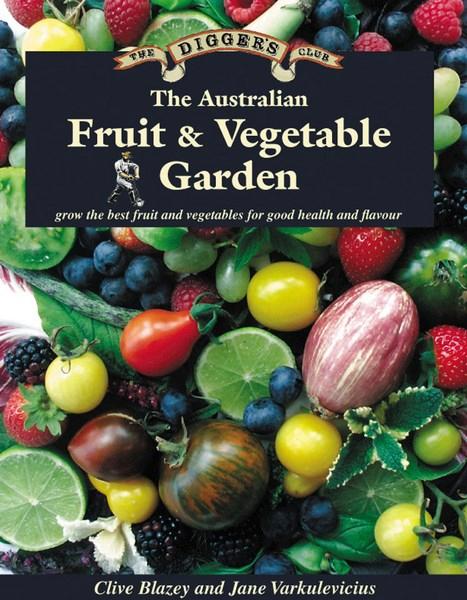 The Australian Fruit and Vegetable Garden: The Digger's Club, by Clive Blazey and Jane Varkulevicius.
The Australian Fruit and Vegetable Garden: The Digger's Club, by Clive Blazey and Jane Varkulevicius. Great general book about growing fruit and vegetables in Australia. Lots of colour photos and very easy to read and learn from. From the publisher, "Dig up your front lawn that is all the space you need to grow the best fruit and vegetables! Peaches dripping with juice and sweetness can only be enjoyed to the full when picked from the tree. At last an authoritative Australian gardening guide that shows gardeners how to integrate food and flowers to create the Garden of Eden for the 21st century! The inclusion of sub-tropical and other fruits extends the interest for gardeners providing 2 books for the price of one.
And The Australian Fruit & Vegetable Garden also includes pages packed with wonderful colour pictures of fruit and vegetables, for the first time comprehensive climate charts covering all Australian conditions and advice from local experts for each climate ideas of food plants to grow for your health.
About the Author: Clive Blazey is the founder and CEO of The Digger's Club. He has helped write four books on flowers, vegetables and fruit gardening. He is a leading opponent of genetically modified seeds and the commoditisation of our supermarket-driven food supply. The club has pioneered the rescue of heirloom vegetable and fruit varieties. Through its nursery, two gardens and bimonthly magazines it seeks to preserve our finest varieties and traditions."
Purchase from Amazon.com.au (Australian Site)
|
Other Survival Books
|
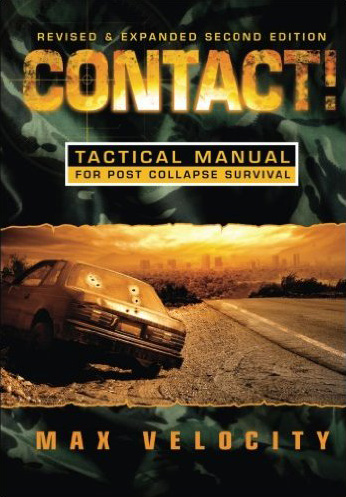 Contact! A Tactical Manual for Post Collapse Survival, by Max Velocity.
Contact! A Tactical Manual for Post Collapse Survival, by Max Velocity. This manual is the result of a detailed consideration of a societal collapse and the civil shift and aftermath that would impact individuals and families who are intent on survival. The purpose of this manual is to provide information to enhance the security, tactics, and survival skills of law-abiding citizens who are faced with civil disorder, lawlessness, violence, and physical threat in a post-collapse environment. The information in this manual is derived from training and experience gained from service with special operations forces (SOF) and subsequent employment as a security contractor in Iraq and Afghanistan. It is a distillation of tactics, techniques and procedures (TTPs) adapted to the threat and environment anticipated in this type of scenario, in order to provide the knowledge needed to survive in a world turned upside down. It is no longer just survival of the fittest but survival of those prepared. The manual will take you from self-defense as an individual, team and family, and on to tactics, techniques, procedures and training that can be used by tactical teams that you may need to form in order to survive or to resist tyranny. In a serious post-event scenario, one of total collapse with several months or years before recovery, families, groups and communities may be forced to create such tactical defense forces to protect personnel, loved ones and resources against hostile forces. There is something in this manual for both the tactical newbie and the military veteran.
Purchase from Amazon.com (USA Site)
Purchase from Amazon.com.au (Australian Site)
|
|
 Nuclear War Survival Skills, Updated and Expanded Edition,
Cresson H. Kearny. This is the "bible" of how to survive a nuclear war. Reading just a small amount of this book will have you convinced that the possibility of surviving a nuclear war is in fact much, much greater than most people believe — provided that you follow a few simple but necessary steps. It explains the basic things you need to to do to protect yourself, especially in the critical first few days after the explosion. The techniques are meant to be used by ordinary people, with access to simple household items, not requiring huge budgets and high-tech shelters.
Nuclear War Survival Skills, Updated and Expanded Edition,
Cresson H. Kearny. This is the "bible" of how to survive a nuclear war. Reading just a small amount of this book will have you convinced that the possibility of surviving a nuclear war is in fact much, much greater than most people believe — provided that you follow a few simple but necessary steps. It explains the basic things you need to to do to protect yourself, especially in the critical first few days after the explosion. The techniques are meant to be used by ordinary people, with access to simple household items, not requiring huge budgets and high-tech shelters.
Nuclear War Survival Skills can be read for free online on the author's website. The online version is the 1987 edition, which is the same as the current 2001 edition except it does not have the addendum on hormesis. Hormesis is the idea that extremely low doses of radiation are not only unharmful, but stimulate the body's defence mechanisms in a way that improves their tolerance to higher doses of radiation that may follow. The addendum is only one page long but it is a good read and adds a positive tone to the end of the book.
It can be downloaded for free from survival.ark.au here.
This book is so good that at the time I originally wrote this, out of 19 reviews, every single reviewer on Amazon.com has rated it 5 out of 5 stars. This is almost never seen. Since then the very few poor reviews are mainly complaining that the book is too old. Hydrogen bombs have been around since the 1950s and things have not really changed that much in terms of how to protect against fallout, blast, etc.
There's also a DVD series by Cresson Kearny, the author of this book, available from here. I have seen the DVDs and they are also extremely good, it's $149 USD for the 8-DVD set. Two or three (possibly more which I haven't found) of the clips from them are available on YouTube (see here).
 NEW Updated 2022 version here from Amazon Australia. "Updated and Expanded 2022 Edition Regarding Ukraine Russia and the World: The Best Book on Any Nuclear Incident Ever." NOTE that you need to buy the paperback, not the hardcover version to get the 2022 updated edition. NEW Updated 2022 version here from Amazon Australia. "Updated and Expanded 2022 Edition Regarding Ukraine Russia and the World: The Best Book on Any Nuclear Incident Ever." NOTE that you need to buy the paperback, not the hardcover version to get the 2022 updated edition.
Click here to Purchase from Amazon (US) Green cover version.
Below is the red cover version, recent 2016 printing.
Purchase red cover version from Australia (The Nile) (Available as of July 2024)
Purchase red cover version from Amazon (US)
Below is the slightly older 2012 "Red Dog" edition which confusingly has a black cover. This version has a smaller page size and more pages than the original.
Purchase black cover version from Australia (The Nile) (Probably unavailable)
Purchase black cover version from Amazon (US) |
|
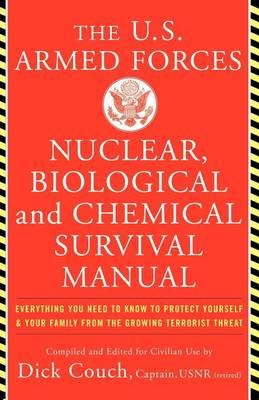 U.S. Armed Forces Nuclear, Biological And Chemical Survival Manual: Everything You Need to Know to Protect Yourself & Your Family From the Growing Terrorist Threat, by Captain Dick Couch and Captain George Galdorisi. 242 pages. The author Captain Dick Couch is a retired Navy SEAL, combat veteran and CIA case officer. The book covers protection from nuclear, biological, and chemical attacks. The chapter on nuclear agents is 22 pages long, plus another 19 pages of appendix about the effects of nuclear agents (like radiation sickness). The rest of the book, covering biological and chemical threats is also very good. U.S. Armed Forces Nuclear, Biological And Chemical Survival Manual: Everything You Need to Know to Protect Yourself & Your Family From the Growing Terrorist Threat, by Captain Dick Couch and Captain George Galdorisi. 242 pages. The author Captain Dick Couch is a retired Navy SEAL, combat veteran and CIA case officer. The book covers protection from nuclear, biological, and chemical attacks. The chapter on nuclear agents is 22 pages long, plus another 19 pages of appendix about the effects of nuclear agents (like radiation sickness). The rest of the book, covering biological and chemical threats is also very good.
There's a chapter covering a comprehensive family action plan. A quote from the retired Secretary of Defence Robert McNamara, referring to the threat of nuclear weapons, says "In some wartime situations a reasonable Civil Defence program could do more to save lives than many active defence measures". The author then says "In fact, I would submit that the threat of attack is higher today than during the Cold War with the prospect of Soviet atomic attack. A Family Emergency Action Plan will do more to save lives than almost any activity carried out by the government". Which is one of the rare cases where the bold font I've used in the quote was not added by myself, but part of the original text.
From the publisher, "It contains the best practices of the United States' military, completely edited and adapted for civilian use. For example, readers will learn how to: Gain knowledge of an impending chemical attack using a simple warning system; Protect against biological threats such as anthrax with a series of inoculations; Guard against fallout from a terrorist nuke; Achieve basic protection during chemical or biological attacks with a simple mask; and Administer first aid after nuclear, chemical or biological attacks with a simple first aid kit. It's all here. This handbook is the single most effective tool for civilians to protect themselves and their loved ones against the threat looming over our homeland."
Purchase or read reviews on Amazon.com.au
Purchase from Amazon (US) |
See Also
Survival Books
Survival DVDs
Books by Tom Brown, Jr.
Permaculture, Self Sufficiency And Sustainable Living Books
Australian Field Guides and Nature Books
Dystopian Fiction / Novels
Books About Near-Death Experiences
Return to Resources
Return to Site Map
amazon amount au australia australian author book books brown bushcraft chemical collapse cover days family field fishpond food forces foxfire free fruit garden gardening great guide handbook information living manual medical modern nile nuclear page pages people permaculture plants read reviews ross self simple site skills special step survival survive threat tom unavailable vegetables version water wilderness without world years
Content is copyright © Survival.org.au 2005-2026 All Rights Reserved. Terms of Use. Definitely read the disclaimer before trying anything from this website, especially including the practices and skills. This website uses affiliate links – this doesn't cost you any more, but I get a commission on purchases made through the website. As an Amazon Associate I earn similarly from qualifying purchases.
|









